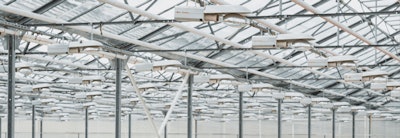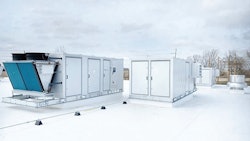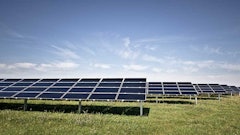

During the past few years, multi-acre greenhouse cultivation operations have been popping up in more and more states. Greenhouses have become even more popular, with the cost per square foot to build lower and ongoing operations more efficient than indoor facilities. Some operations started with plans to expand over time, while others grew with demand and cash flow. Both business models come with major challenges in any climate—and even more so in the ever-changing cannabis market. Here are seven considerations when taking on a massive greenhouse buildout or expansion.
1. Climate (Location, Location, Location)
One of the main benefits of greenhouse growing is the ability to use natural sunlight and the environment around you to lower production costs. The easiest way to maximize that benefit is to build your greenhouse in the most stable climate possible.
While there are a number of factors to consider, including real estate development costs and the distance to markets for distribution, one of your main objectives should be to avoid locations with severe and sudden weather changes. A stable exterior climate will help double down on those production savings by not having to use increasingly valuable resources to balance the greenhouse growing environment. Try to avoid places with high winds that may limit the amount your vents could open or growing on a mountainside where the natural light could be blocked for extended hours during the day. Look for locations with high daily light intervals, low daily temperature swings, stable humidity, and low winds. All these separate forces can work against your greenhouse, causing you to use more mechanical means of heating, lighting, venting, or cooling.
2. Resources
Other considerations related to location include the availability of power, water, and other resources around you. Bringing in the amount of power or water needed to run a major greenhouse operation can be a huge unforeseen expense if not researched properly. Talk to local authorities to find out the exact legalities of water and waste rights for the property to grow cannabis to make sure you will not be restricted or experience an unforeseen tax for your water or waste disposal.
Easily accessing and receiving equipment, supplies and services also becomes a major asset that can not only save money on shipping costs, but can save you from losing a crop if an emergency happens. Being able to get supplies locally means you can save money by picking up small orders yourself that can save you thousands per year in shipping. And getting parts or specialists in a hurry becomes invaluable if your roof blows open and you need a temporary cover or if a cooling system goes out and you must get an HVAC company to fix it. The sooner you can get those repairs done, the less stress and damage done to the plants—not to mention labor hours lost.
3. Timing
After finding a suitable plot of land with the appropriate resources, you now need to figure out how and when you want to begin the construction and growing process.
One advantage of growing your own product is being able to control when it is going to be available and, if you are in a newly legal state and lucky enough to receive one of the first cultivation licenses, the value of your product may never be more valuable than within the first few months the market opens. New markets typically have more demand than supply, so suppliers are almost able to name their price. The quicker you can get your product to market, the more valuable it will be most of the time. Taking this into consideration when constructing the greenhouse, your ability to get part of the cultivation space approved for growing before the whole facility is constructed can help you get your product to market earlier. Perhaps you can build out your structure and get the electrical, plumbing, and everything else done in the vegetative growing spaces to get a certificate of occupancy, since those spaces are typically closed off from the flowering areas. If you are building multiple greenhouses or buildings, try to finish one greenhouse completely before starting the next facility. By saving that time, you can dictate the market price as one of the early producers in your state.
In contrast, if you are already in a state with an established market, your priorities will vary. If you are in a location with harsh winters, then finishing your greenhouse expansion before the coldest season may be the biggest goal. Or, if you plan to build multiple separate greenhouses as part of an upgrade, strategically time jobs so that when one crew finishes pouring the foundation, for example, the construction crew is ready to start building the frame. That way you never miss a day where something could be progressing.
If licensing limitations are your main obstacle, try to plan based on when you can get more plants or canopy square footage. Being able to scale your business based on state limitations can be challenging, but staying on top of when you are able to resubmit for expansions means you will not miss a day when you could be growing those extra plants.
4. Hiring
One of the most important considerations to plan for in today’s job market is making sure you have a reliable workforce that can run the operation. Labor is an increasingly valuable asset, especially since the COVID-19 pandemic started, making hiring more challenging and payrolls more expensive. If possible, automate as much as your budget can allow while planning for future upgrades so that you will be able to easily install equipment when the time comes. But invest enough in automation to make sure the workforce will be able to reliably and consistently do their jobs. Purchasing equipment like pot fillers, conveyor belts, and automated trimmers removes the more tedious aspects of the job and allows your crew to focus on tasks that bring more value to the product. Try to have your crew ready to go from day one and, if possible, hire managers earlier so they can start their training before the rest of the team shows up. Scaling up the workforce along with the workload as you get up and running is important because the number of employees needed to initially run the operation will be fewer and directly affected by the amount of automation that has been set up in the greenhouse. For example, using conveyor belts to move plants, pot fillers to fill pots, and automation to irrigate all plants can equate to needing just three to four employees per acre, compared with needing double that if automation systems are not in place.

5. Environmental Controls
Providing the ideal environment for plants is essential for your business to succeed. Without the proper understanding of climate controls, how they work, and their limitations, your greenhouse can easily be too large to heat or cool, not to mention many other problems that can occur.
Fortunately, most greenhouse manufacturers can give you an accurate representation of what their greenhouses are capable of in certain climates, as well as their limitations. Depending on the setpoints needed, the manufacturer should be able to give you some options on how to keep the greenhouse at that level consistently. Most modern greenhouses will have some sort of automated control system that will function as a brain for the growing environment, and manufacturers will often have one that they are most comfortable with installing based on reliability, software, learnability, and customer service.
Heating may not be as important in a southern and more temperate climate as it is in northern states, but there is always room to be more efficient and cost-effective. One example is using radiant floor heating in addition to atmospheric heaters to save millions of BTUs. However, southern states definitely need to focus on cooling and, if possible, using a wet wall and fan combo is often the cheapest and most efficient way to cool most greenhouses. Work with your manufacturer to find the most efficient system that will bring the best cost savings overall.
6. Supplemental Lighting
Additional systems controlled by the greenhouse brain include lights and blackout systems. Lights ideally should have multiple control options to avoid inefficiencies, such as running them unnecessarily when the natural light is bright enough or when they will cause you to use another resource like extra cooling during the day to save you from overheating. In turn, you will save energy, money, and the plants from being stressed. The blackout system can be very customizable depending on your greenhouse and can work many ways, but the main objective is total darkness to make sure your plants will flower in summer when sunlight exceeds 12 hours per day. Some manufacturers have side curtains to darken clear wall material, while others use blacked out material for the sides and only have a mechanical curtain in the roof.
7. Redundancy
If the budget allows, install redundant systems to save money or save you in an emergency. For example, having multiple ways to cool the environment down—such as using adjustable shade cloths with motors that can be opened electrically or manually along the roof in addition to an evaporative cooler—is important. Shade cloths may reduce your available sunlight temporarily, but they will also drop the greenhouse temperature quickly by using one motor instead of having to rely only on continuous power to run fans and water for an evaporative cooler, or a potentially even more costly cooling method.
Conclusion
Taking on a project like a massive greenhouse expansion rarely comes to fruition without an insane amount of thought, planning, and capital. Most companies trying to build large greenhouses have already experienced success in a market where not a lot is guaranteed and legislation can be slow, but there have also been many failures and projects that never lived up to their potential. This is the case in any industry, and as the cannabis industry continues to grow in new markets, you must be ready to adapt. At the minimum, keeping some of these tips in mind may save you from an easy mistake that could cost you your business.
























